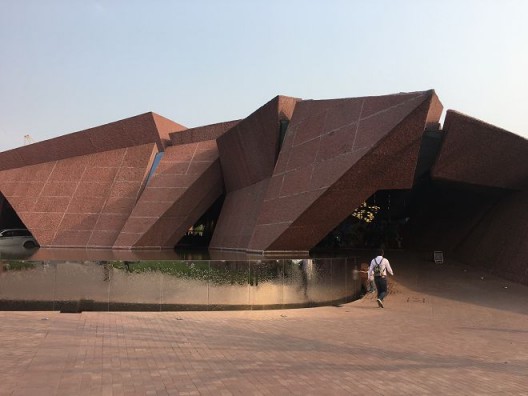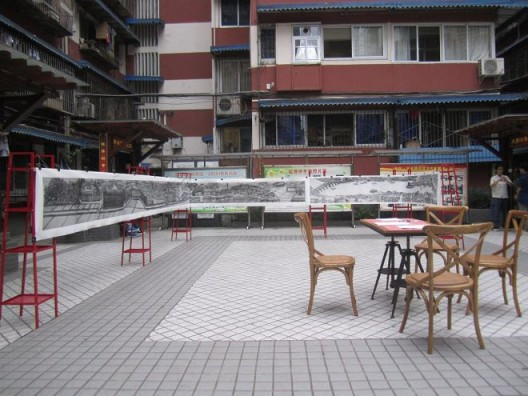A long ride out into through the peri-urban sprawl to an institution anchored in a real estate development does not usually inspire confidence. As I descended the stairs into an expansive room filled with an architectural model of the Luxelakes community, I was fully expecting a kind of Potemkin museum engineered to add glamour to this remote corner of Chengdu.
Though in its layout the museum makes no secret of its relationship to real estate, Luxelakes·A4 Art Museum (formerly the A4 Arts Center)—which re-opened its doors in a new location at Luxelakes Eco-City in Tianfu Chengdu this April—seems intent on expanding its functions beyond the remit of filling halls with things and inviting the public to take selfies. Rather, it seems to be fulfilling the functions of a living, breathing, and most importantly “thinking” institution—one intent on creating a culture of museum-going, nurturing the local art ecosystem, and even asking a few tough questions along the way.
Though the museum re-launched with the rather anodyne theme of “Create Spaces”, there were nonetheless a few critical works contained within the show, which reflect the attitude of the museum. Artists Zhu Ye and Wei Haoyan of “NOFFICE” 嗯工作室 launched a harpoon at the cookie-cutter perfection of the Luxelakes community (complete with artificial lake, petting zoo, and privileged children trotting around a riding arena on ponies) with their archival research project “Secrets of the Streets: Chengdu”. “Secrets of the Streets” collected specimens of community and street life including old furniture, announcements from the local neighborhood committee, bao’an kiosk (including bao’an lady), an on-site mahjong game, placing all of these artifacts in the museum, thus “museifying” it in the manner of a fossil or 3000-year-old mummy.


This forms part of a greater critical stance of the museum with its focus on “Zaidi xiangmu” (在地项目)—site-specific projects which shine a light on various aspects of local life—a thoughtful reflection on the forces of capital and property which are driving the gentrification and even extinction of local communities, providing an alternative to both capitalist and official discourses.
Exhibition and Academic Department director and curator Li Jie, spoke with us about the the research artists Chen Jianjun and Cao Minghao have done into Chengdu’s water systems:
“We gave the artists the task of understanding the water systems of the whole geographic area of Chengdu . . . Historically we learned that Chengdu used to be an inland Venice where the canals and the land routes were very important means of transportation. The residents back then could open up the the door of their house and step into a boat, but now the situation is very frightening; the withering of the agricultural sector, the impact of industry. Now water is like a golden crown; everyone is running after it, but no one is able to get it. Lots of rivers have become sand pits providing materials for the construction industry and production of concrete.”
The brand of social practice Li Jie and his artists are engaging in is not so much in the kind of “feel-good” spectacles which employ the public as pawns to stage some kind of innocuous social message (“You too can make a difference! Cue applause and mutual back patting!”), but rather they seek more to investigate the complex social, political and economic relationships which form the engine of Chengdu’s rapid transformation.
The site-specific projects are long-term, non-goal oriented (i.e. an exhibition may not be the end result) and often involve collaboration with NGOs who understand local issues. As Li Jie notes, “The artists become social workers living in the city and they talk with the residents and the volunteers about their thoughts on life.” In Cao Minghao and Chen Jianun’s project “Rooftop and the Wall”, the artists did an exchange of skills teaching an elderly resident, Ms. Gong, teaching her some basic painting skills which she used to create a contemporary Chengdu version of the scroll painting of “Along the River at Qingming Festival”.
“That scroll was interesting because it rewrote Chengdu’s history . . . like an official map of Chengdu’s water ways, because she could remember which homes were by which rivers, the first one was a noodle shop, the second was a tofu stand, the third was a temple and so on, it was very very clear. And she would glean a lot of [information] from other elderly people, so the artists followed this old lady and through chatting, discussing and communicating with her, and worked on it a long time.”
This scroll as a product of “Gong Ayi’s” oral history acted not as a work in itself but part of a larger installation, but before it was brought to the museum, it was first exhibited in Ms. Gong’s neighborhood as part of a workshop. Finally NGOs, scholars and residents were invited to the museum for discussions with art organizations involved in social practice, such as Shanghai’s Dinghaiqiao Mutual Aid Society and Yunnan’s Artist in Transit Project.



In addition to creating bonds with local communities thus taking the museum outside of the museum, Li Jie, a former artist himself, is keen to help support the local art ecosystem, providing artists professional guidance through their careers in the form of long terms collaborations and dialogue. One might say “support”, but he dislikes the use of the word “support” because of the implied power dynamics. Their young artists project “Artist Case Studies”, which as been running for six years, rather than being focused on the end product is more about nurturing the artist’s practice than about generating works and exhibitions. Li states that “It was more about the kinds of difficulties or transitions you were encountering in your work and what you were thinking about at the time. So during this year we were always circling around and breaking through [i.e. overcoming certain barriers in their practice]. And when you wanted to have a breakthrough with your practice you would often . . . make mistakes. And you need to accept these failures. In order for new things to come out, there need to be mistakes and so actually we are encouraging the artists to try new things.”
Without taking an overly optimistic view, it seems that Li Jie is really intent on growing the scene, bringing new artists into the fold and providing some meaningful contributions rather than just padding his own reputation. “At the beginning there were not many artists doing experimental art,” says Li Jie, but through these collaborations they managed to introduce new artists, or perhaps re-classify artists who had previously considered themselves as working in more traditional or non-contemporary modalities:
“We were like an incubator at the beginning and we encouraged the artists to experiment to make them to [do] some site-specific projects and enter into this research phase, then a year or two later after the research is done we have them participate in experimental projects. After this we follow their practice and we hope to recommend them to participate in some residency projects to open their eyes which becomes an important stage of their lives.”
Artists working in the Artist Case Studies Project often got the chance to collaborate internationally with Yokohama Creative City Center and Kyoto Art Center in Japan—which offer residencies to Chinese artists, relationships that serve to strengthen pan-Asian ties. . . all this at a time when such things are politically popular.
Bringing Japanese artists from their collaborating institutions to Chengdu, A4 also aims to create a dialogue with Chengdu-specific issues, as Junko Maruyama’s Wild Flower Field which employed a by-product of the local food economy as a medium: “The artist after being here for two months ate a lot of hotpot and he had this question which we had no idea how to answer. He asked ‘where does all this oil go?’ And we said ‘they chuck it out’ and he said what a waste, because he was very environmentally conscious. He said that he studied a soap making process in Taiwan and he could collect all of this oil and make soap out of it. He found a way of getting the spiciness out of the oil but he couldn’t get rid of the red color.”
Through this work of nurturing cross-national ties, local communities and the Chengdu art ecosystem do a great deal for the scene, frankly the general public—the bread and butter of most museum audiences—doesn’t really care about an artist’s process or personal growth.



The museum, however, seems acutely aware of the need to serve different demographics in order to reach sustainability. Besides having different kinds of spaces for different attention levels (for instance the Luxelakes Eco Art Center which features animations, sculptures and installations about water and nature conservation, lighter fare for the casual museum goer with tots in tow) they also produced three different guidebooks to their exhibition “Creating Spaces”, aimed at children, teens and adults, to accompany a rich program of tours, workshops and more academic discussions. Li Jie himself last year conducted over several hundred curatorial tours, along with those given by volunteers. These tours also serve a dual function providing opportunities for market research as each of the tour conductors feed back visitor reactions into a centralized system which the staff can use to create better visitor experiences in the future.
A4 seems to grasp the concept of a museum in a holistic way. They see the museum not as merely an exhibition hall, a landing strip for some exhibition created elsewhere, shipped in like a travelling circus. They understand that museums can contribute to the both the art scene and local communities, that they can simultaneously produce knowledge and respond to the needs of their local audience. In a sense, what they are doing is far more three-dimensional than the Luxelakes mock-up which sits in their lobby, and certainly a great deal more than many of the token museums which garnish real estate projects from Chengdu to Shanghai.




















